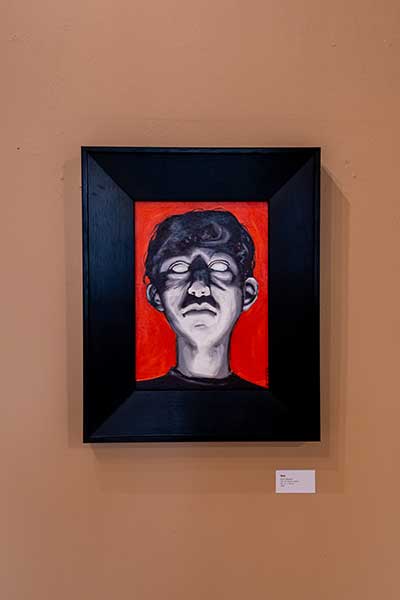By John Anthony S. Estolloso
NOVEMBER 16 witnessed Thrive Art Gallery’s opening of a new exhibit: a selection of oils by Kat Malazarte and protégé Kira Uygongco, showcasing a profoundly thoughtful though nascent partnership that bore fruit to a sundry collection of portraits and still-lifes.
The intention of the exhibit is introspective. Despite the predominance of the female form and face in many of the canvases, one can hardly call it a feminist exhibit: there is no commentary about oppression, discrimination, or empowerment. Rather, the flavor is more autobiographical, resonant of the collection’s title: Introspection – A Spirit Journey. To emphasize this theme, what easily caught the eye of the viewers would be a large canvas in the middle of the exhibit, an eponymously collaborative composition by both artists, capturing their figures beneath the bower of a tree, even as they indulge in their artmaking.
At a glance, Kat Malazarte’s art exudes her mastery of oils. The wall-text of the exhibit speaks of her métier: specializing in the classical, her canvases are evocative of the traditionally representational in art, one that gravitates towards the True, the Good, and the Beautiful. This aesthetic worldview permeating her technique is seen in her figures’ demure expressions or in their carefully choreographed poses, their personas shrouded by an almost stolid sensibility, hovering between the serious and the homely. Beyond portraiture, her animal figures are, at the very least, charming; in execution, these are impressionistic with a twinge of familiarity that tends to comfort rather than disturb.
Refracting these works through a different lens, she has an apprentice aspiring to follow her footsteps albeit with a distinctly personal aesthetic style.
While it is far too early to say that Kira Uygongco is a burgeoning novice in the local art scene, she has undoubtedly the glimmers of a painter. One might be tempted to call her canvases ‘derivative’, gleaning much inspiration from social media. Yet, the transmutation of these images as paint-spattered iterations abounds with personal sentiment and interpretation: then again, how do great artists begin in their craft if not through imitation? Noteworthy as well is how these pieces show early signs of impressionist tendencies, leaning more towards impasto textures in oil. Altogether, they show promise, and given perhaps more time with canvas, brush, and paint, she will find her own niche among our local artists.
As for their subjects, they mostly project the feminine face and figure, subtly nuanced yet expressively repressed. The penchant for portraying animals seems to be a recurring theme as well; as if to provide a restful aside, the occasional landscape surfaces. Throughout these sundry subjects, the same impressionist technique come to light and while we discount what was considered modern during Monet’s heyday, we can very much consider both of their artworks as truly influenced by the classical.
* * * * *
When asked about the exhibit’s title, curator Joseph Albaña explained the underlying theme that wove through the collection: the artists’ aesthetic self-searching manifesting itself through the diverging styles, emanating from the painters’ mentor-mentee relationship. That it was anchored on personal discernments and preferences made the artistic process all the more introspective – something that was both reflective and revealing on the part of the artists.
Mentorship in art has always been a revered cycle which rejuvenates and preserves artistic traditions, finetuning the art scene to what is contemporary and enshrining what is deemed resonant in the canon – the student following the master through slow yet sure steps, the former searching her own aesthetic path and space in the artworld, even if that means deviating from the dictums of the latter. With that in mind, the exhibit may be read as an aesthetic crossroads for the painters: for Malazarte, it is a continuing journey; for Uygongco, it may be an auspicious start. And for whichever pathways they may choose, we just might hear more of their names in future exhibitions.
(The writer is the subject area coordinator for Social Studies in one of the private schools in the city. The photos are from Ziel Harder, for Thrive Art Projects.)






























